Glossary of Lucite Terms
Every industry has its own insider lingo, including ours. Here is a list of some of the key terms to help you navigate the wonderful world of mementos, deal toys, and tombstones!
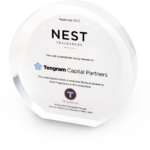 Acetate — A clear film that is printed and embedded into acrylic. Once embedded, the film almost disappears and artwork seems to be floating within the acrylic piece.
Acetate — A clear film that is printed and embedded into acrylic. Once embedded, the film almost disappears and artwork seems to be floating within the acrylic piece.
Acrylic — Clear or opaque plastic material used to make deal toys. Dupont’s commercial name for it is Lucite, which is what many people call it.
Acrystone – Acrylic with a swirled or speckled effect to look like granite or marble.
Bevel — Angled edge, usually with a surface width of around 1/8”.
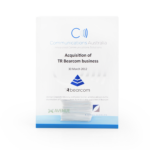 Colored bottom — Poured or embedded acrylic that is a different color from the body of the lucite. The factories can match any PMS color, or they can do a variety of stock translucent tints. The bottom can be straight or slanted inside the clear acrylic.
Colored bottom — Poured or embedded acrylic that is a different color from the body of the lucite. The factories can match any PMS color, or they can do a variety of stock translucent tints. The bottom can be straight or slanted inside the clear acrylic.
Colorfill — Ink added to laser-engraved text that literally fills the letters or images with color. Most commonly used on glass, metal and crystal.
Deal Toy, Deal Gift, Lucite, Memento, Tombstone – Terms used to describe awards commemorating business, real estate or legal transactions. These can be made of acrylic, crystal, resin, wood, metal, or a combination of materials.
Die-Cutting — The use of sharp steel blades to cut a specific shape from printed sheets. Often used for tombstones with simple shapes. If a more complex shape is needed, a laser is used to cut the shape instead.
Digital decal – A CMYK printed sticker that is wrapped around the deal toy. Unlike a direct transfer, it is not baked, so it can peel off or bubble.
 Digital Print — A high-resolution image printed on paper, film or a metal plate. This is a good alternative to silkscreening since only 1 or 2 setup charges are required (vs. 1 per spot color for silkscreen). Often, white needs to be printed behind the print on transparencies, to make the color look bright and opaque. Digital printing is not a good option if the client is very concerned about the exact reproduction of colors, because some (blues in particular) do not always print with total accuracy. Often abbreviated as DP.
Digital Print — A high-resolution image printed on paper, film or a metal plate. This is a good alternative to silkscreening since only 1 or 2 setup charges are required (vs. 1 per spot color for silkscreen). Often, white needs to be printed behind the print on transparencies, to make the color look bright and opaque. Digital printing is not a good option if the client is very concerned about the exact reproduction of colors, because some (blues in particular) do not always print with total accuracy. Often abbreviated as DP.
Digital transparency – a clear piece of film used for digitally printing artwork in CMYK, which is then embedded in clear lucite. This produces a translucent effect, so it is often paired with a white silkscreen on the back to make it opaque. This is specified on art as “digital transparency + white.”
Direct Surface Print – A high-resolution digital print that is baked onto the surface of the piece. It often has a coating of white on the back to make it more opaque (direct surface print + white). A surface print cannot go all the way to the edge of a lucite—there needs to be a 1/32” tolerance on all sides.
Direct Transfer Print – A high-resolution digital decal that is baked onto the surface of a piece. It often has a coating of white on the back to make it more opaque (direct transfer print + white). Transfer prints can go all the way to the edges, which makes it more versatile than an embedded print or a Direct Surface Print.
 Embedment — Any item that is placed into lucite and baked in. Embedments can be metal (softer metals, like pewter, work best), wood, thermoplastic, or paper. When a client wants to embed something unusual, we generally send it to the factory to do a test. Some items will melt, pull away from the acrylic, or create bubbles in the surrounding acrylic.
Embedment — Any item that is placed into lucite and baked in. Embedments can be metal (softer metals, like pewter, work best), wood, thermoplastic, or paper. When a client wants to embed something unusual, we generally send it to the factory to do a test. Some items will melt, pull away from the acrylic, or create bubbles in the surrounding acrylic.
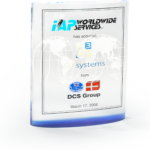 Etch — Incising text or art into the base material using a laser. Many different depths and textures of etch and high levels of detail can be achieved, including 3D etches (which are limited to crystal).
Etch — Incising text or art into the base material using a laser. Many different depths and textures of etch and high levels of detail can be achieved, including 3D etches (which are limited to crystal).
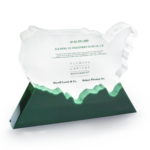 Frost or frost effect — Semi-opaque effect achieved either by sandblasting, laser-etching or printing a thin coat of white ink on clear acrylic or glass.
Frost or frost effect — Semi-opaque effect achieved either by sandblasting, laser-etching or printing a thin coat of white ink on clear acrylic or glass.
Laser etch – a process used to engrave text or art into lucite, glass, metal, crystal or wood. Deep etch specifies a more dimensional etch. More than 1 depth of etch can be used on the same piece.
Lucite (LOO-cyte) — Dupont’s trade name for acrylic. Also often used to describe deal toys in general. The material comes in powdered form and is baked and then polished to create a hard, shiny surface. Available in any PMS color as well as almost any translucent or solid shade and in granite and marble textures. Even glow-in-the-dark lucite is now available. Lucite can also be painted to create metallic and antiqued finishes.
Metal plate — Used instead of a card or piece of film for printing the deal terms. Brass or nickel plates can be used, though metal is more problematic to embed–it can bubble around the edges or pull away from the acrylic when it is heated. Can be laser-cut into custom shapes.
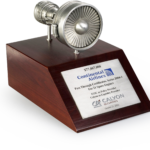 Metal Casting — Miniature metal figurine used as an embedment in an acrylic piece. Usually made of a soft metal such as pewter, which can then be plated in different finishes and metal colors.
Metal Casting — Miniature metal figurine used as an embedment in an acrylic piece. Usually made of a soft metal such as pewter, which can then be plated in different finishes and metal colors.
Mirror Ink – A highly shiny and reflective ink that creates a mirror when printed on acrylic or glass. Sometimes used to hide glue when connecting two clear pieces of lucite.
Pantone Matching System (PMS) – A standardized collection of colors with numbers assigned to them so that designers, printers and manufacturers can be assured they are printing the exact color(s) required.
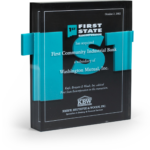 Plexiglas – Acrylic sheets available in different thicknesses and many colors, including translucent and Pantone. Often laser-cut into shapes and used as embedments in Lucite.
Plexiglas – Acrylic sheets available in different thicknesses and many colors, including translucent and Pantone. Often laser-cut into shapes and used as embedments in Lucite.
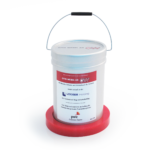 Resin — Opaque plastic substance that can be molded and painted. It is more expensive and time-consuming to produce than lucite, but more detailed and accurate models can be made using resin. A good option if the client has a very specific item to reproduce, and has plenty of time and budget.
Resin — Opaque plastic substance that can be molded and painted. It is more expensive and time-consuming to produce than lucite, but more detailed and accurate models can be made using resin. A good option if the client has a very specific item to reproduce, and has plenty of time and budget.
Sandblast — Used to create a semi-opaque surface, usually on the back of a clear award. Usually used when the deal terms are printed on clear film, since it makes the print more legible.
Sandblast effect – Surface printing using a semi-opaque ink that replicates the look of sandblast, usually for less money. This is especially cost-effective when client wants a clear logo on a frosted background.
Silkscreen – Spot color printing. Especially useful when exact colors need to be replicated, including Pantones.
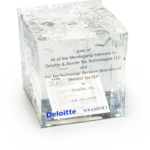 Slant bottom — Wedge embedded at the bottom of a lucite, so that the deal terms can be viewed on an angle. Can be clear or can match any color.
Slant bottom — Wedge embedded at the bottom of a lucite, so that the deal terms can be viewed on an angle. Can be clear or can match any color.
Soft Scrub — A less expensive and less opaque form of sandblasting.
Surface print — Art that is printed directly onto the surface of the lucite, as opposed to being printed on a card or acetate and embedded. You can print much closer to the edges of a piece using surface print rather than embedding. Almost any color, including metallics, can be surface-printed.
 3D laser etch – A process that etches a fully dimensional image inside a crystal shape. The piece must be at least 1.5” thick for this to be done.
3D laser etch – A process that etches a fully dimensional image inside a crystal shape. The piece must be at least 1.5” thick for this to be done.
Tombstone — Term used either to describe the deal terms and logos that are embedded inside a memento, or to describe the entire memento itself. Often abbreviated as TS.

